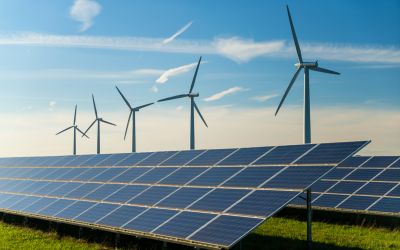Rachel Schiftan on defining and setting net-zero goals
Rachel Schiftan, Senior Managing Director of Sustainability Services at Cushman & Wakefield talked to Climate Action about how firms are translating net zero goals into tangible progress.
.png)
We’re halfway to 2050 – how are firms progressing on their net-zero goals?
As of mid-2024, many of the world’s largest public companies are making progress towards their net-zero goals by setting ambitious targets, embracing Science Based Targets Initiative (SBTi) frameworks, and increasingly focusing on energy-efficient building practices. About 90% of 200 of the world’s largest public companies are maintaining or accelerating their net-zero commitments, according to a PwC survey. Out of the companies surveyed, 37% heightened their targets or expedited their timelines. Roughly 53% maintained their original goals, and 5% not disclosed any net-zero plans1
While the survey indicates that 90% are either maintaining or accelerating their commitments, the progress toward those goals is mixed. Only 56% are on track to achieve their short-term Scope 1 and 2 emissions targets - addressing direct emissions from a company’s operations and indirect emissions from its energy use. And just 22% are progressing toward their Scope 3 goals to target emissions outside of the company’s control (i.e. supply chain, business travel).
So while we are encouraged by the aggressiveness of the targets, the progress being made against those targets are facing some challenges as companies must calculate their approach to decarbonization and have a detailed plan, build a balanced portfolio of projects that provide short-term and long-term returns on investment, and execute plans effectively. That being said, we are seeing consumers and employees demanding action, investors are favoring it, regulations are requiring it so we expect to see more companies motivated to step up their commitments.
What is their definition of net zero and how are they tracking towards the goal while acquiring and disposing of properties in their portfolios?
When firms—whether in real estate, investment, or other sectors—define net zero in the context of their portfolios, they are typically aiming to eliminate or offset the carbon emissions associated with both their operations and the assets within their portfolios. However, the exact definition of "net zero" and how firms track progress towards this goal can vary depending on their industry, the scope of their operations, and their commitment to climate action.
In the context of real estate or investment portfolios, net-zero generally means the firm is striving to:
- Reduce carbon emissions from its operations and value chain to as close to zero as possible (through energy efficiency, renewable energy adoption, etc.).
- Remove any remaining emissions (e.g., through nature-based solutions like reforestation or technologies like direct air capture and storage).
Tracking net-zero progress requires both quantitative and qualitative methods and a structured process to assess and reduce emissions, often using a combination of internal systems, third-party assessments, and industry standards.
When acquiring properties, firms typically follow specific due diligence processes to ensure that the properties align with their long-term net-zero goals. This may involve:
- Assessing Existing Emissions of Properties - evaluate the carbon footprint of the property, including its operational emissions, embodied carbon, and potential for energy efficiency improvements.
- Building Sustainability Features into Acquisition Criteria – set sustainability criteria for new acquisitions (e.g., properties that are already energy-efficient or capable of achieving high energy-efficiency standards, buildings with the potential for solar panels or access to district heating systems, etc.).
- Future-Proofing Acquisitions - consider not only current emissions but also future regulatory risks (e.g., potential carbon taxes or energy efficiency regulations).
When disposing of properties, firms typically look to ensure that these disposals do not undermine their progress toward net zero. This may involve:
- Evaluating the Carbon Impact of Disposal - assess carbon footprint, including any potential emissions generated by demolition or renovations.
- Repurposing and Recycling - prioritize material recycling, ensuring that building materials are reused or repurposed to minimize waste and embodied carbon.
- Engaging with Buyers on Sustainability - engage with potential buyers to ensure they are committed to sustainable practices and can continue reducing emissions post-sale.
When acquiring or disposing of properties, the carbon impact of these transactions is assessed, and strategic decisions are made to ensure alignment with long-term sustainability goals.
Are organizations adapting the DOE’s zero emissions building definition as their net zero North Star?
In June 2024, The U.S. Department of Energy (DOE) announced a National Definition of a Zero Emissions Building Part 1: Operational Emissions from Energy Use to advance public and private sector efforts to decarbonize the buildings sector2. The intent of this definition is to set forth a standardized, consistent, and measurable minimum criteria for buildings toward zero emissions. In broad strokes, it specifies three required steps for any building to achieve zero operational emissions: it must be energy efficient, have no fossil fuel combustion on site, and be powered by renewable energy sources, which can be on-site, off-site, or a combination of both.
The recently released framework is a major step forward, but much work remains. It is noteworthy that DOE’s criteria for buildings with zero operational emissions from energy use comprise only “Part I” of the definition. This suggests that future parts of the definition may address considerations that fall outside the scope of operational emissions, e.g., embodied carbon, refrigerant use. Future incorporation of these types of factors into the definition have the potential to influence building design and broader development efforts over time. Furthermore, the DOE’s definition does not provide verification standard, nor will the agency certify whether a building meets this criteria under this definition. Since the announcement, 8 major green building certification programs in the U.S. announced that they will embed, align, or exceed the zero emissions definition within their certification. We may see new state and local laws around building performance standards incorporating the new federal definition for zero emissions buildings. Thus, this newly established federal definition of may drive both industry and regulators toward a more standardized framework for assessing building energy and emissions performance. Companies seeking to comply with state and local net-zero requirements or making voluntary net-zero claims should begin to evaluate their sustainability performance in light of DOE’s definition.
1 https://www.pwc.com/us/en/services/esg/library/decarbonization-strategic-plan.html
2 https://www.energy.gov/articles/doe-announces-national-definition-zero-emissions-building






